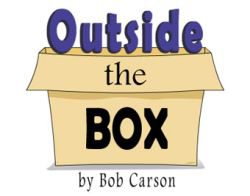Theories of Relativity
July 22, 2019,Editor’s Note: The USTA website is pleased to present freelance writer Bob Carson and his popular “Outside the Box” features. This monthly series is a menu of outlandish proposals presented with a wink — but the purpose behind them is serious. The views contained in this column are that of the author alone, and do not necessarily represent the opinions or views of the United States Trotting Association.
Last December, a strange addiction gripped me.
This surprising situation began with a single harness horse race. A 2-year-old pacing colt began his racing career at Monticello Raceway. The horse, named Charliewoolf, caught my attention because he is the son of a mare my partner and I once raced. My interest began as a mere curiosity.
The first time I logged in to watch Charliewoolf race was nothing unusual. It was just another race with unfamiliar racehorses. The only exception was that I had a slight attachment to one of the horses. A week later, with almost the exact same cast of horses, I watched this race again and the race felt a bit more familiar. This non-winners of one race became a bit of a recurring little drama. Each week a horse graduated to the next class and another stepped in to take its place on the racetrack, but the core group of competitors remained. Charliewoolf did not graduate from this class. He tried his best, but to this point, his best is third place.
 To me, the strange part of this rather mundane report is how the fate of Charliewoolf and this handful of competitors, all 3- and 4-year-olds, lured me back to watching and wagering on the races. Watching this small herd of racehorses evolved into a happy routine. Each Friday I looked up the entries. Monday I purchased a program, although the field soon became so familiar that a program was barely needed. On Wednesday, I watched and wagered on the race. I wanted to see how it played out.
To me, the strange part of this rather mundane report is how the fate of Charliewoolf and this handful of competitors, all 3- and 4-year-olds, lured me back to watching and wagering on the races. Watching this small herd of racehorses evolved into a happy routine. Each Friday I looked up the entries. Monday I purchased a program, although the field soon became so familiar that a program was barely needed. On Wednesday, I watched and wagered on the race. I wanted to see how it played out.
For serious gamblers, this familiarity with each member of a crew of lower level warriors is a useful handicapping angle. However, and this statement may be blasphemy, winning money is not the reason that I logged in to watch these races. Watching a good race with this little gang felt different. The obscure unfolding drama was the lure.
The owner of the winner was happy, other owners cashing a check were happy, and this made me happy. Watching the dynamics of the core group and how they fared against the occasional new horse felt like a quiet, friendly, corner in a very busy world. These racehorses tried hard and their fate meant a great deal to the owners and trainers.
It is difficult to explain my attraction to these races. Psychological intervention might be required. Yet, without a doubt, logging on to watch these familiar horses drew my money and my attention. Fast paces at top racetracks with horses racing a full ten seconds faster, for ten times the purse money, did not have the same attraction.
I did not miss a race with this group of horses for months. My massive weekly input to the wagering pool ($10) has remained constant.
Somewhere in this odd little side road were lessons that led to the rekindling of my interest in racing. It is likely my interest level received a boost because this small group focused my attention. They became familiar and an attachment was developed. I wanted these horses to do well and make progress.
A relationship, no matter how tenuous, is a powerful magnet. For those of us who arrived post-internet, tales are told of full grandstands and robust engagement in the sport of harness racing. These tales are like the legends of the Knights of the Round Table.
Prior to the invention of the internet, gamblers and fans were filtered to the local racetrack. With a local track, bonds were formed and friendships created. Loyalty to drivers, horses, trainers, and owners at your home racetrack were factors. Pre-internet, the harness racing world was local and relatively small.
Decades ago, the opportunities for emotional connections were plentiful. Simply standing by the rail and watching the horses go by as the driver nodded to you was a way of engaging everyone in the sport. Placing a bet was a tactile experience.
In the modern horse racing marketplace, the barn doors are wide open — information, statistics, and replays are virtually unlimited for gamblers, fans, and owners. However, the ability to engage emotionally is difficult when the player is using a cell phone or a laptop.
This engagement factor becomes more complex when modern technology opens the door to every track and every harness race horse. Clicking onto a race about to go off at an unknown racetrack with unfamiliar horses that are owned and raced by unfamiliar people becomes merely an exercise of numbers and statistics.
This is fine for many gamblers. Gambling and money are the foundations of racing, they always have been. However, emotional engagement is an asset we should not ignore. This small group of racehorses riveted my attention, which demonstrated to me that the connection does not need to be deep to take root.
The little group of a dozen or so horses remained primarily names to me — Charliewoolf, Steuben Iron Lady, Chappy Hour, Mightyoaks Katara, Pennys Dragon, etc. The human connections — Nick Clegg, Sean Smithpeters, John Stubits, Daniel Gill, Mike Doherty, etc. had no context. But, even though they were just names, my repeat visits to watch the races made me feel as if we had a bond.
More depth would make the connections easier and the fragile bond stronger. Can this happen in the digital world? Why not.
If some of these horses and people had been accessible via a link at the racetrack homepage, deeper connections would have been created. It is not necessary to link to life stories or epic essays, just a few breadcrumbs that would be of interest to many potential followers. This could be simple information such as how a horse came to be at a particular barn, what issues the horse has overcome, why the name of the horse was chosen, what other racehorses are in the family, and what are the hobbies of trainers and owners. The idea is to offer little threads that can create bonds.
Continuity was a factor in my fixation with these races. The consistency of my appointment with these inconsistent horses was critical. My Wednesday dates at the NW/1 races at Monticello decreased when “my gang” began to fade away, but for a few wonderful months I was happy in my little niche with my odd bunch of hopefuls.
Perhaps creative minds can construct more of these little digital harness racing Mayberrys. Perhaps we can use modern technology to establish bonds and set up races where the feelings are warm and emotionally the races are more than mere products.

